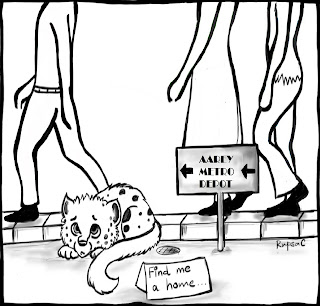Mapping the Experience: Saying it like it is
 |
| cartoon by Rupsa Chakraborty |
The coming up of the Metro shed in Aarey is a bone of
contention among many environmental activists. As part of our final semester assessment, we got a project to create a multi-pronged campaign to garner support on the issue.
When we were given the project, I was skeptical about the
impact we would be able to make. A lot has already been done and is being done,
for Aarey, and I didn’t think that our efforts would make a dent.
The group as a whole was also not sure of what we could possibly
achieve as mere college students when so many, much more experienced people before
us have tried without measurable success.
At the same time, as mass media students, we tend to believe ourselves
as people who will change the world with good and honest journalism. This idea
invariably pushed us to do the work we ended up doing.
We gave each other different roles suggested by our
professor. That really helped us get a clear idea of what needed to be done,
who was going to do what and how we were going to complete our tasks. Initially
on the first day when we got the assignment, we excitedly chalked out a plan of
action, shared it with our professor, and divided the tasks.
By the second day, the excitement for some reason had
considerably died down. By the next week, we had checked off three of the many
things we had planned to do and somehow found that enough.
We kept tweaking our initial plan throughout (not that it
was a bad thing) and though not exactly what we had set out to achieve, I’m
still content with the work we did.
We got petitions signed by people in our neighborhood and
got a satisfactory response. The social media campaign was a huge success
partly due to our collaboration with Mid Day cartoonist Rupsa Chakraborty whose
thought-provoking cartoons on the repercussion of Metro shed in Aarey garnered a
lot of social media attention.
At the end of the project, I was pleasantly surprised by the
outcome. Now I know more about the Save Aarey issue than I ever did before and
have become more sensitive to environment issues. Also, I was greatly relieved
as well, as any student is when a project is done and dusted.
Every project has something to teach and there will be quite
a few lessons I’ll take away from this assignment.
One, leave your preconceived notions behind when you do a
project involving a social or environmental issue. The world works differently
than you might think. The ground reality is not how the mainstream media or you
make it out to be.
Two, don’t be too ambitious. Setting a goal is important,
yes, but practicality is key. Factoring in the available sources and
constraints, if any, is essential for success.
Three, don’t confuse awareness with action. Most times, we
think that doing our bit for an issue means creating awareness about it. We
think wrong. Specifically in the case of the Save Aarey campaign, there is
already enough media coverage to last a lifetime. People already know what’s
wrong. We have to get people to act to make things right. Awareness and action
are not interchangeable.
Finally, standing up for issues is important. Standing up
for issues we believe in; issues that deserve our time and effort. We might not
change everything but we will definitely contribute to the bigger scheme of
things, and sometimes, that is enough.
 |
| cartoon by Rupsa Chakraborty |
This post is a part of a media class assignment: Mapping the Experience to share our views of the projects we work on
.jpg)

Comments
Post a Comment